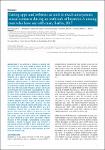Dating apps and websites as tools to reach anonymous sexual contacts during an outbreak of hepatitis A among men who have sex with men, Berlin, 2017
Ruscher, Claudia
Werber, Dirk
Thoulass, Janine
Zimmermann, Ruth
Eckardt, Matthias
Winter, Christian
Sagebiel, Daniel
Background
In an outbreak of hepatitis A among men who have sex with men (MSM) in Berlin (2016 and 2017), patients frequently reported anonymous sex and use of dating applications to meet sexual contacts, hampering tracing and vaccination of contacts.
Aim
Our objective was to evaluate dating apps and websites as a means of spreading prevention messages among MSM during the ongoing outbreak.
Methods
Advertisements in different formats were placed on three MSM dating apps and eight websites for anonymous dating during three weeks in March and April 2017. We calculated frequency of ads shown and click-through rates (CTR) and investigated the independent effect of format and platform on the number of clicks using a negative binomial regression model. We evaluated the campaign’s impact using a survey among visitors of a large gay-lesbian street-festival in Berlin.
Results
Overall, 1,920,180 ads were shown and clicked on 8,831 times (CTR = 0.46%). The multivariable model showed significantly more clicks on one dating app (incidence rate ratio (IRR) = 9.5; 95% confidence interval (CI): 7.7–12.2) than on websites and on full-screen ads (IRR = 3.1; 95% CI: 2.5–3.8) than on banner ads. Of 266 MSM who participated in the survey, 190 (71%) knew about the outbreak and 39 (15%) declared to have been vaccinated recently because of the campaign.
Conclusions
Dating apps provided a means to rapidly reach and influence a substantial number of MSM in Berlin and should complement case-based contact tracing among MSM in outbreak settings. Clicking on ads depended on platform and format used.

